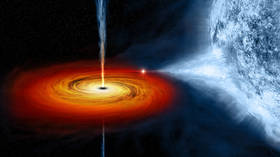Ripples in space & time suggest black hole may have swallowed neutron star

Astronomers say they may have spotted a neutron star being swallowed by a black hole for very the first time after seeing vast gravitational waves rippling across space.
The waves were spotted by the twin Ligo observatory in the US and the Virgo detector in Italy following a possible collision on April 26.
If confirmed the important detection could shed vital insight into what exactly happens when stars crash into black holes. The burning questions include whether the star was ripped apart before being consumed by the black hole or whether it merely glided into oblivion.
Also on rt.com Astronomers ‘gobsmacked’ by black hole so powerful it’s dragging space behind itThe detectors work by picking up the minute ripples in the fabric of space and time that roll across the universe when two massive objects collide. Patrick Brady, a spokesperson for Ligo and a professor of physics at the University of Wisconsin-Milwaukee, said the signal from the potential collision is “rather weak” and the astronomers need to thoroughly examine all the data before they can confirm the event.
“It’s like listening to somebody whisper a word in a busy café; it can be difficult to make out the word or even to be sure that the person whispered at all. It will take some time to reach a conclusion about this candidate,” he said.
The location of the possible crash has been narrowed to approximately three percent of the sky some 1.3 billion light years away. Astronomers across the world are now focusing their observations on this area of space in a bid to collect more information.
Like this story? Share it with a friend!













